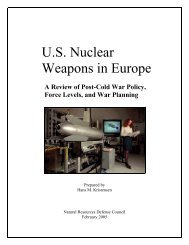NRDC: No Breathing in the Aisles: Diesel Exhaust Inside School ...
NRDC: No Breathing in the Aisles: Diesel Exhaust Inside School ...
NRDC: No Breathing in the Aisles: Diesel Exhaust Inside School ...
Create successful ePaper yourself
Turn your PDF publications into a flip-book with our unique Google optimized e-Paper software.
CHAPTER 6<br />
AFTERTREATMENT,<br />
REPOWERS, AND REBUILDS:<br />
HOW WE CAN MAKE<br />
OUR EXISTING DIESEL<br />
SCHOOL BUS FLEET CLEANER<br />
As this report details, <strong>the</strong> best long-term protection for children’s health is for school<br />
districts to transition <strong>the</strong>ir diesel school bus fleets to alternative fuels, such as<br />
natural gas and propane, and ultimately to zero emission technologies. There are<br />
at least three short-term options, however, for school districts to reduce <strong>the</strong> emissions of <strong>the</strong>ir<br />
exist<strong>in</strong>g diesel school bus fleet prior to retirement: aftertreatment, repowers, and rebuilds.<br />
PM Aftertreatment. <strong>School</strong> districts can choose to retrofit <strong>the</strong>ir exist<strong>in</strong>g diesel school buses<br />
with PM aftertreatment technology (particulate traps) if <strong>the</strong>y can purchase low-sulfur diesel<br />
fuel, which is necessary for <strong>the</strong> traps to function properly. PM traps essentially collect, or<br />
“trap,” particles from <strong>the</strong> exhaust stream <strong>in</strong>to a filter and, over time, literally burn (also<br />
referred to as regeneration or oxidation) <strong>the</strong> collected particles off <strong>the</strong> trap when <strong>the</strong> eng<strong>in</strong>e<br />
reaches a certa<strong>in</strong> temperature. The California Air Resources Board (CARB) anticipates that<br />
particulate traps, when properly operated us<strong>in</strong>g low-sulfur diesel fuel, could reduce diesel PM<br />
emissions by 90 percent with an 85 percent control efficiency. 117 CARB also estimates that<br />
diesel PM traps will cost approximately $6,000 per bus with an <strong>in</strong>cremental cost of $0.05 per<br />
gallon of low-sulfur diesel fuel. 118 The cost of low-sulfur diesel fuel sold elsewhere <strong>in</strong> <strong>the</strong><br />
country may be higher. For example, <strong>in</strong> New York City, <strong>the</strong> price for 30 ppm sulfur diesel<br />
fuel can be 12 cents per gallon more than for conventional diesel fuel. 119 In California, $12.5<br />
million from <strong>the</strong> State’s Low Emission <strong>School</strong> Bus Program (see Chapter 7 for details) has<br />
been set aside specifically to help school districts pay for <strong>the</strong> retrofit of exist<strong>in</strong>g fleets and for<br />
<strong>the</strong> <strong>in</strong>cremental costs of low-sulfur diesel fuel. 120 More fund<strong>in</strong>g is needed, however, both <strong>in</strong><br />
California and throughout <strong>the</strong> country.<br />
The pr<strong>in</strong>cipal impediment to a nationwide retrofit program is that low-sulfur diesel fuel<br />
(15 ppm or less) will not be widely available until 2006, pursuant to EPA’s December 2000<br />
regulation. In addition, concerns have been raised by eng<strong>in</strong>e manufacturers that even <strong>the</strong><br />
15 ppm sulfur content required by 2006 may be too high for PM aftertreatment devices to<br />
function at optimal levels or rema<strong>in</strong> durable over time. Also, although PM aftertreatment<br />
33
















